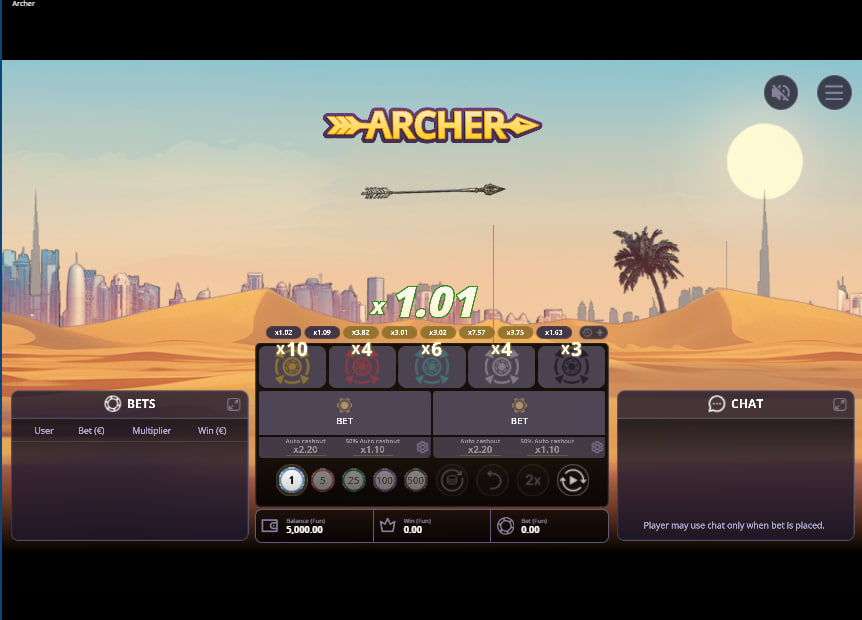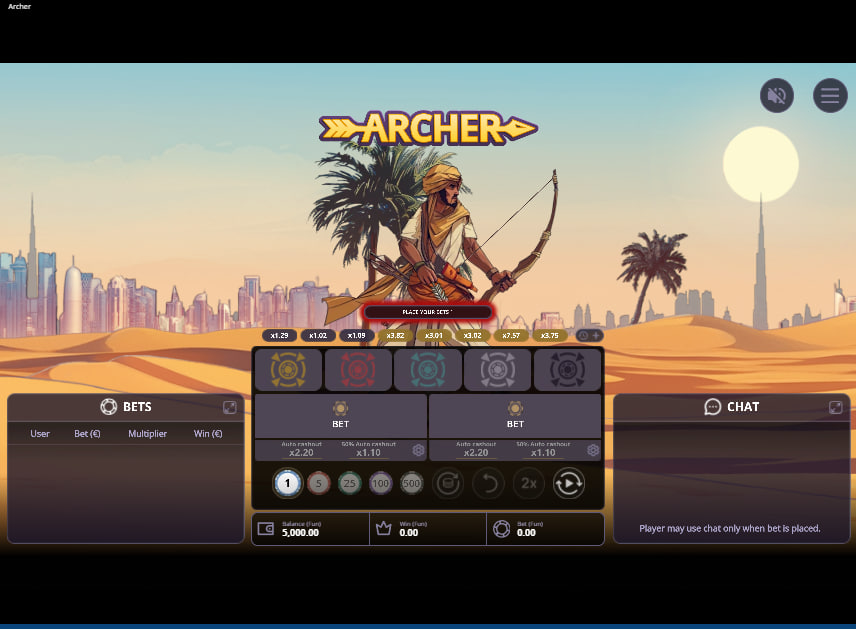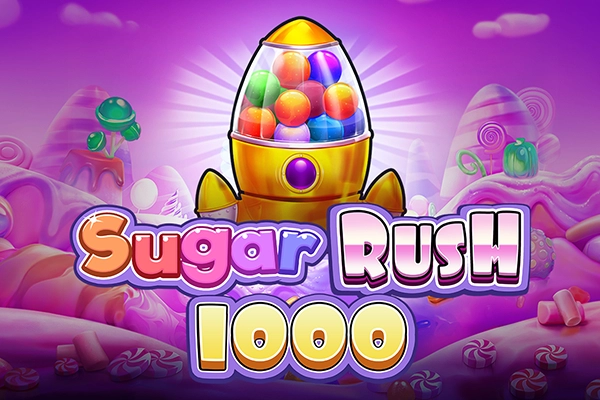OneTouch’s Archer presents a calculated take on the crash game genre, focusing on strategic player control over pure chance. The game establishes a distinct atmosphere by setting a traditionally clad archer against a futuristic desert metropolis backdrop. This visual contrast heightens the suspense inherent in its core mechanic. The layout is not based on reels, but on a single rising multiplier that players must cash out from before the round ends abruptly. Archer’s defining characteristic is its dual-bet system, which permits two separate wagers with independent strategies in the same round. This is further deepened by a 50% cashout option for advanced risk management. A secondary “Lucky Shot” side bet introduces a fixed-odds predictive element to the gameplay. With a primary game RTP of 97.00%, the title offers a solid statistical foundation. Archer is structured for players who appreciate direct influence over their game’s outcome and enjoy multi-layered betting systems.
OneTouch presents Archer, a title that positions itself within the crash game genre, a category known for its straightforward yet tense gameplay loop. Instead of relying on spinning reels and paylines, this game's foundation is built on a rising multiplier and the critical decision of when to collect a payout. What sets Archer apart from many of its contemporaries is not a radical reinvention of this core concept, but rather the introduction of sophisticated betting systems and a secondary wagering layer. The game's visual identity, a curious fusion of ancient desert archery with a hyper-modern city backdrop, provides a distinct canvas for the action. For the seasoned player familiar with crash mechanics, the primary points of interest will be the dual independent betting slots, the strategic 50% cashout option, and the entirely separate “Lucky Shot” side bet.

Core Gameplay and Advanced Betting Structures
The fundamental premise of Archer is direct. A round begins, and an arrow is loosed, its flight path corresponding to an ascending multiplier that starts at 1.01x. The player's objective is to manually or automatically cash out their stake before the arrow's journey abruptly ends, an event that forfeits any uncollected wagers for that round. The innovation here lies in the betting interface. Players are provided with two separate and identical betting panels, allowing for the placement of two concurrent but entirely independent wagers within the same game round.
This dual-bet system immediately opens up a broader range of strategic approaches compared to single-bet crash games. A player might, for example, designate one bet as a conservative play, setting a low auto-cashout target (e.g., 1.5x) to consistently secure small returns. Simultaneously, the second bet can be treated as a high-risk, high-reward venture, allowed to run in pursuit of much larger multipliers. This structure effectively allows players to hedge their own risk within a single round, a level of control that is a considerable asset.
Further enhancing this strategic depth is the 50% Cashout feature. This function allows a player to secure half of their potential winnings at a chosen multiplier while leaving the remaining half of the stake in play. For instance, on a €10 bet, a player could execute a 50% cashout at a 3.00x multiplier. This action would lock in a €15 return (€5 stake x 3.00), while the other €5 stake continues to ride the ascending multiplier. This mechanism is a commendable addition, offering a level of risk management not commonly found in simpler crash game formats. It transforms the binary decision of “cash out or wait” into a more nuanced calculation of risk apportionment.
The Lucky Shot Side Bet System
Operating in parallel to the main crash game is the Lucky Shot side bet, a feature that functions as a completely separate game of chance. This wager does not concern itself with the main multiplier's value or the timing of the cashout. Instead, it is a predictive bet on the outcome of a secondary event that resolves at the end of each round. Above the main betting interface, a series of five colored targets is displayed. The objective of the Lucky Shot bet is to correctly predict which of these five colored targets the arrow will symbolically “hit.”
Placing a side bet is optional and does not require a main bet to be active. The potential payouts are tied directly to the color of the target, with each color corresponding to a fixed multiplier for the side bet stake. The specified multipliers are: x3, x4, x5, x7, x9, x15, x27, x45, x90, and x180. The distribution and probability of each color appearing are governed by the game's internal random number generator. This side bet introduces a distinct element of fixed-odds wagering, appealing to players who enjoy lottery-style mechanics. It serves as an interesting counterpoint to the main game, which involves a greater degree of player agency and timing. The statistical probability for this side bet is defined by a 96.13% RTP, a separate figure from the main game's RTP.
Strategic Automation and Control Features
A key component of engaging with Archer effectively involves mastering its automation tools. These are not merely for convenience; they are integral to executing a consistent strategy and removing the potential for emotion-driven errors during a tense round. The most prominent of these is the Auto Cashout function. For each of the two main bet slots, a player can pre-define a specific multiplier value. Once the in-game multiplier reaches this value, the bet is automatically cashed out. This is the primary tool for implementing the aforementioned strategies, such as setting a low, “safe” target for one bet and a higher, more ambitious target for the other.
The game also includes a comprehensive Auto Play feature. This allows the player to configure a series of consecutive rounds to run without manual intervention. The settings are detailed, allowing for pre-set bet amounts, auto cashout values, and conditions for stopping the auto-play sequence, such as a set number of rounds or loss/win limits. The interplay between the dual main bets, the 50% cashout option, and the auto cashout function creates complex strategic possibilities. If the precise execution of the 50% cashout combined with automation is not immediately clear, launching the demo Archer version and accessing the in-game help file (usually marked with an ‘i') provides a detailed, step-by-step breakdown from the developer. These tools collectively shift the player's focus from rapid manual clicks to thoughtful pre-round setup and strategy formulation.
Visual Presentation and Thematic Execution
The aesthetic of Archer is one of its more curious aspects. The foreground is dominated by a skillfully drawn character in desert garb, poised with a bow. The setting is a vast expanse of sand dunes under a hazy sun. This classical imagery is starkly contrasted by the background: a silhouette of a futuristic, almost sci-fi city skyline, reminiscent of modern metropolises like Dubai. This blend of ancient tradition and advanced civilization is an interesting choice, avoiding more common fantasy or purely historical themes. It creates a distinct, if somewhat ambiguous, sense of place.
The animation is clean and functional. The central visual element is the arrow itself, rendered in a pixel-art style that clashes intentionally with the painterly background. It flies smoothly across the screen as the multiplier value ticks up beside it. The “crash” is represented by the arrow shattering. The animations are not overly elaborate, which is appropriate for a game where clarity of information (the current multiplier) is paramount. The user interface, a signature of OneTouch, is exceptionally well-organized. Information is logically compartmentalized into modules for betting, social interaction, and game history. This clean layout ensures that even with the dual-bet and side-bet systems active, the screen never feels cluttered, which is a significant design accomplishment. The overall atmosphere is less about immersion in a story and more about fostering a state of focused anticipation.

Social Integration and Developer Insight
Like many titles in the crash genre, Archer incorporates a strong social element that is central to the experience. A persistent “BETS” panel is visible on the screen, displaying a live list of the usernames, bet amounts, and cashout multipliers of other active players. This is more than just a cosmetic feature; it creates a tangible sense of a shared, communal event. Observing the strategies of others—who is cashing out early, who is holding on for massive multipliers—can be both informative and entertaining, adding a layer of metagame to the proceedings.
A chat function is also included, allowing for direct communication between players. Notably, the ability to chat is enabled only after a player has placed a bet for the current or upcoming round. This is a practical design choice by OneTouch, as it tends to keep the conversation focused on the game at hand and reduces the likelihood of irrelevant spam. The multiplayer components are handled seamlessly, with no discernible lag in the updating of player bet lists or chat messages. This speaks to OneTouch's experience in developing mobile-first, lightweight games that perform well even with multiple real-time data streams. The developer has successfully built a game that feels like a collective experience rather than a solitary one, which is a key reason for the enduring appeal of the crash game format.

 Archer
Archer












